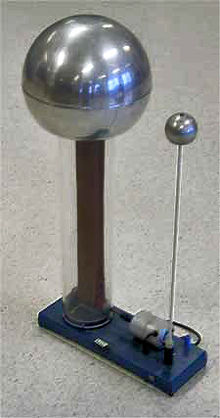Van de Graaff generator

Van de Graaff generator.
|
|
| Uses | Accelerating electrons to sterilize food and process materials, accelerating protons for nuclear physics experiments, producing energetic X-ray beams in nuclear medicine, physics education, entertainment |
|---|---|
| Inventor | Robert J. Van de Graaff |
| Related items | , linear particle accelerator |
A Van de Graaff generator is an electrostatic generator which uses a moving belt to accumulate electric charge on a hollow metal globe on the top of an insulated column, creating very high electric potentials. It produces very high voltage direct current (DC) electricity at low current levels. It was invented by American physicist Robert J. Van de Graaff during 1929. The potential difference achieved by modern Van de Graaff generators can be as much as 5 megavolts. A tabletop version can produce on the order of 100,000 volts and can store enough energy to produce a visible spark. Small Van de Graaff machines are produced for entertainment, and for physics education to teach electrostatics; larger ones are displayed in some science museums.
The Van de Graaff generator was developed as a particle accelerator for physics research, its high potential is used to accelerate subatomic particles to great speeds in an evacuated tube. It was the most powerful type of accelerator of the 1930s until the cyclotron was developed. Van de Graaff generators are still used as accelerators to generate energetic particle and x-ray beams for nuclear medicine research. In order to double the voltage, two generators are often used together, one generating positive and the other negative potential; this is termed a tandem Van de Graaff accelerator. For example, the Brookhaven National Laboratory Tandem Van de Graaff achieves about 30 million volts of potential difference.
The voltage produced by an open-air Van de Graaff machine is limited by arcing and corona discharge to about 5 megavolts. Most modern industrial machines are enclosed in a pressurized tank of insulating gas; these can achieve potentials of as much as about 25 megavolts.
...
Wikipedia
